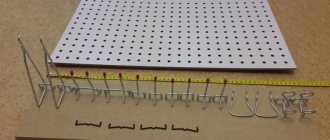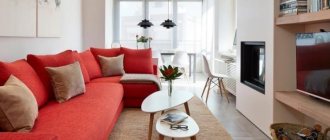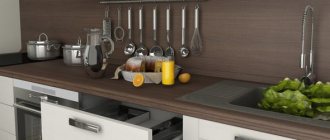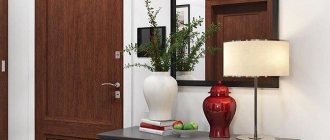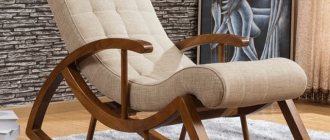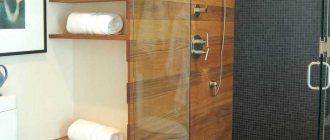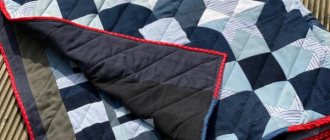Pros and cons of using screens
Lightweight furnishings are attractive for their versatility: they look equally good in both spacious and small rooms. The products have many advantages and therefore are very popular at the moment.
The advantages of these decorative elements include:
- light weight and compactness, allowing you to move the item from one place to another;
- low price provided you make the screen yourself from scrap materials;
- the possibility of increasing the area of the structure due to additional elements in the form of pockets, shelves or hooks;
- many options for decorating a room thanks to the variety of screen designs;
- the ability to create a screen partition with your own hands in accordance with the size of the room.
Minor disadvantages include:
- lack of sound insulation;
- instability of the structure.
Since the product plays a decorative role in the room, the disadvantages can be considered insignificant.
What features should the product have?
Before you start designing it, you need to consider that it must meet certain requirements. Firstly, the product must be as light as possible so that if it accidentally tips over, it cannot injure anyone. In addition, the light weight will make it possible to move the structure throughout the apartment, and the kids themselves will be able to do this. Secondly, the screen must be made stable. Therefore, use very durable materials in your work: wood, high-quality plastic or light metal. What you will use to decorate the facade is up to you, but all material must be environmentally friendly, safe, and free from any defects.
Variety of species
If previously screens were simple and of the same type, modern models amaze with the variety of shapes, sizes, materials and design options. To decide to make a screen partition for a room with your own hands, you should get acquainted with the various design options.
You need to choose a suitable model based on the shape and size of the room, interior features and your preferences.
Wooden frame and fabric
This model deserves attention most of all, because it is the “progenitor” of all other designs. The advantages of such a screen are elegance, a classic look, ideal for any interior, availability of materials, and relatively high (except for the time it takes for the glue to dry) speed of work.
Casement model
A classic product consisting of a durable frame, the elements of which are connected to each other either using piano hinges or parts made of thick fabric or leather.
The most common are three-leaf structures, but four-leaf ones are also found. The number of elements depends on the area of the room. The height of the product reaches 180-200 cm.
Closed screen. Cooking stages
A partition made of ordinary vines will look elegant in your garden plot. It is better to use horizontal weaving. In order for the vine to last a long time, it must be cut in winter or autumn with a knife with a smooth and sharp blade at an angle. The rods must be stored tied in a bundle; before use, they should be “revitalized” - placed in a container with water. After a few weeks, the branches swell, so the bark can be easily removed from them. In order to maintain a silky and shiny surface, it is necessary to adhere to the correct drying technology. To do this, bunches of vines are laid out on a wooden lattice in the open air and periodically turned over so that the sun and air evenly affect the rods. To maintain flexibility and elasticity after the water procedure, they are wrapped in a wet blanket, thick fabric or bedspread. It is better to dry the remaining rods to avoid the formation of fungus. Only after this can you start working.
Single screen model
This partition consists of one continuous leaf. For stability, it is either attached to the floor or fixed with one edge to the wall. This deprives the product of mobility.
Single-screen screens are often installed in offices to delimit workspaces, in kitchens to highlight a dining area, in studio apartments to designate the living, sleeping and kitchen areas of space.
Single-leaf partitions have also found their use in small cafes or restaurants to separate tables from each other.
Garden partition
Screens are not only used for puppet shows; they can serve various functions: supports for plants in the garden, decoration or architectural structures.
Depending on the style in which the garden is decorated, the partition is selected. But any style has its own rules, and they must be followed. Most often, the screen is made by hand in a small size and with a lattice design.
The most suitable place for it is a patio or a green lawn; a corner screen is used to protect, for example, a summer kitchen from a children's playground.
Transparent model
A decorative element of the interior of any shape and size, having an openwork fabric that does not hide what is on the other side. Either translucent fabric or mesh is stretched over the frame. Products of this type are used only for decorating the room.
Note!
Do-it-yourself installation of interior doors - preparation of the structure, selection of doors, installation step by step + instructions from professionalsDIY shoe rack - types of designs, manufacturing materials, step-by-step master class with simple diagrams and drawings
Do-it-yourself sliding wardrobe - manufacturing manual with a full description of the stages, types of structures, choice of manufacturing materials (photo + video)
Making your own screen
An ideal option for independent creativity would be to make your own screens from wood and fabric. This classic model will look perfect in any interior. You can assemble it easily and quickly if you use the tips and recommendations on how to make a screen with your own hands.
The essence of the work is that you need to stretch a piece of textile onto a wooden frame. The product model can be any: book, folded or single-screen.
The main task is to decide in which room the structure will be located and choose the fabric of the desired color so that it fits harmoniously into the decor.
The process of creating a screen begins with preparing the essentials:
- bars in the amount of 12 pieces measuring 170x2 cm and 12 pieces measuring 60x2 cm;
- piece of fabric;
- paint and varnish products;
- glue;
- decorative elements;
- power tools;
- fasteners;
- sandpaper.
Next you need to act in accordance with the step-by-step instructions:
- Using a ruler and pencil, mark the bars to assemble the frame.
- In the designated places, make cuts up to half of the wooden parts.
- Using a chisel and hammer, make a depression in the cut area.
- Assemble the wooden parts into the frame, first smearing the joints with wood glue.
- After the glue has dried, sand the finished frame with sandpaper and varnish.
- To strengthen the structure, fix the joints of the frame with screws to the metal corners.
- After making the frame, you can prepare the textile part of the screen. The fabric cut must match the size of the frame with allowances for hems. If it is not possible to use a whole piece, you can create a patchwork composition.
- Using a furniture stapler, secure the fabric to the frame, starting from the top. To prevent the fabric from sagging in the future, it must be fixed with tension.
- The structural parts covered with fabric must be connected with furniture hinges, piano hinges or textile elements.
Piano hinges or fabric connections allow the product to be folded in any direction.
Master class No. 2: two-color screen
You will need:
- 3 Doors
- 6 loops
- Screwdriver
- Primer and paint
- Brush
Step 1. Wash the doors from dust and dirt. Let them dry.
Step 2. Assembling the screen. Connect the two doors with three hinges along the entire height of the doors. Make sure the doors are level before connecting them. After this, attach the third door using the three remaining hinges. If the doors don't match in size or pattern, it's not a big deal.
Step 3. Attach the loops:
- If you use small loops, you will need 3 pieces, if large, then two will be enough.
- Align the two doors using a screwdriver and connect them with three hinges along their length.
- Turn the doors over so that the hinges face the floor. Attach the third door in the same way, but to the opposite side of the second door. The connecting elements of the hinges must be on the outside.
Step 4. Painting:
- Prime the door to hide any imperfections.
- Use a brush for the grooves in the door and a roller for the rest of the surface.
When painting the sides in different colors, pay attention to the following. Apply the second type of paint only to the right edges of the first and third doors. Paint only the left center with the second type of paint. Once the doors are installed, you will not notice a different paint color.
Cute and colorful! Install either the white side or the pink side.
Flexible tube partition
Among modern models, bamboo structures are very popular, but they are quite expensive. You can make a screen from cardboard tubes from fabric rolls and style it as bamboo branches.
To assemble it, you should prepare the necessary material:
- From 15 to 30 cardboard blanks, depending on the desired length of the product;
- cutting tools;
- marking accessories;
- awl;
- decorative durable thread;
- acrylic paint in cans in a color that imitates wood or stems.
Next you should act in accordance with the recommendations:
- Prepare tubes of different lengths to give the product a natural look.
- Paint the workpieces.
- Use an awl to make holes at the upper and lower ends of the tubes.
- Thread a cord through the holes and connect the structural elements.
This decorative piece of furniture will resemble a picket fence made of reeds or bamboo. It will be lightweight and can be conveniently rolled up. It can be given any shape to fit into the interior of the room.
It should be remembered that products made of cardboard are afraid of moisture, and a structure made of tubes will not be as reliable as a self-made wooden screen.
With a little creative ingenuity and some effort, you can make an original piece of furniture yourself and give your home an exclusive look.
Design options
When the main work of creating the screen is completed, you can think about how to decorate it. Or rather, this should be thought through in advance, even at the preparation stage. After all, a new piece of furniture must be combined with the main style of the room.
If, for example, the room is decorated in oriental style , then fabric drapery, rhinestones, and beads would be appropriate. If this is a marine style, then you can safely add a little marine theme to the screen made of burlap or ropes - pebbles, shells, an anchor or a miniature steering wheel.
If there is an artist in the house, you can stretch the canvas over some parts of the screen or over one of the parts and paint a landscape. Little novice artists can paint pictures on cardboard.
For a screen made from branches, it would be appropriate to add leaves or flowers, as well as natural materials.
If you need to see what the finished screen will look like, you can look at ready-made examples.
- The screen, decorated with a mosaic of colored glass, looks unusually beautiful. It will decorate any room and fit into many styles.
- This is how festive and stylish the design made of twigs looks, to which garlands of lights are added.
- A screen simply covered with fabric also looks harmonious. The main thing is that it fits into the overall interior, as in this case.
- And this is what an option that you can create together with your children looks like. To do this, you need to cut out parts from cardboard and fasten them together.
A master class on making a screen using available materials is presented in the video.

